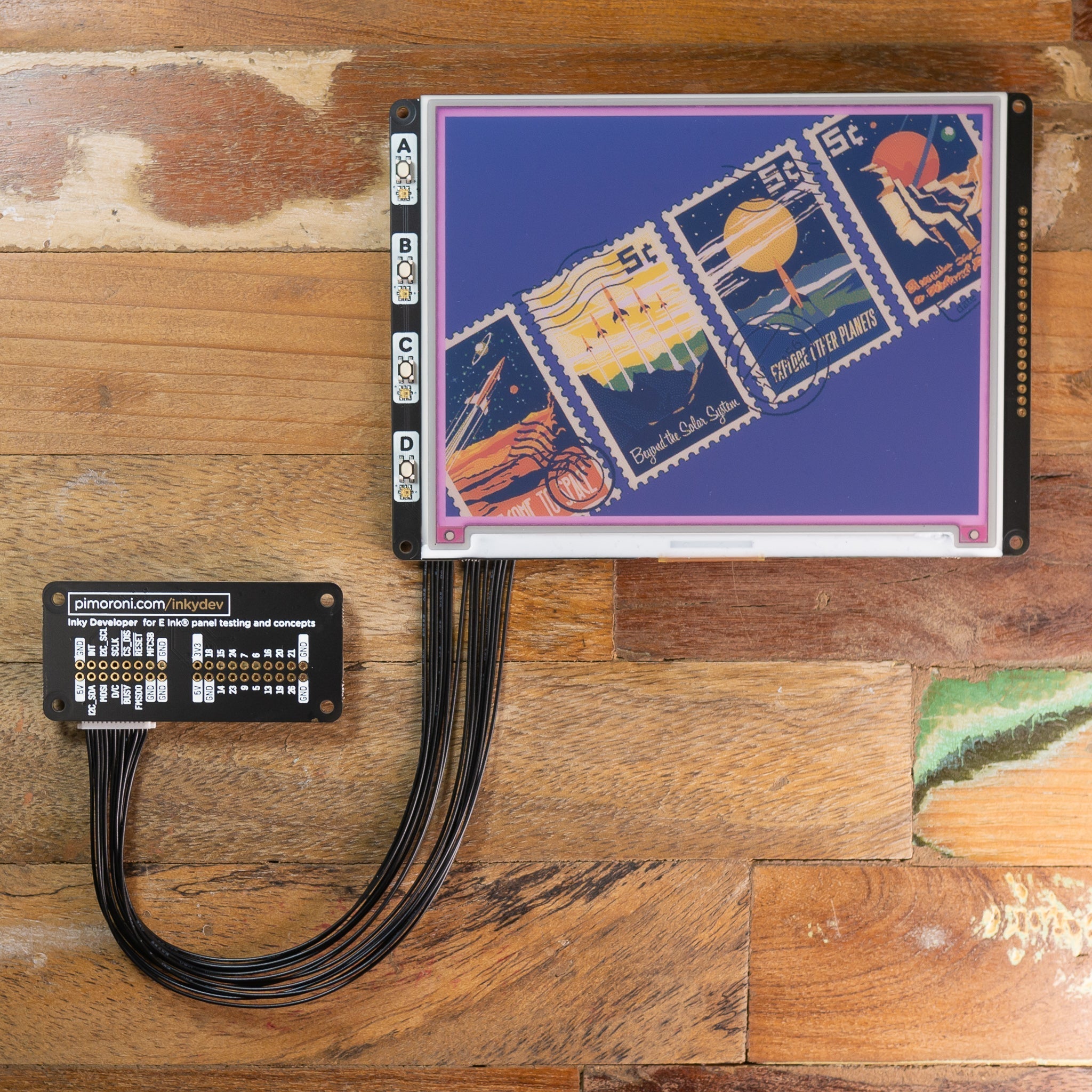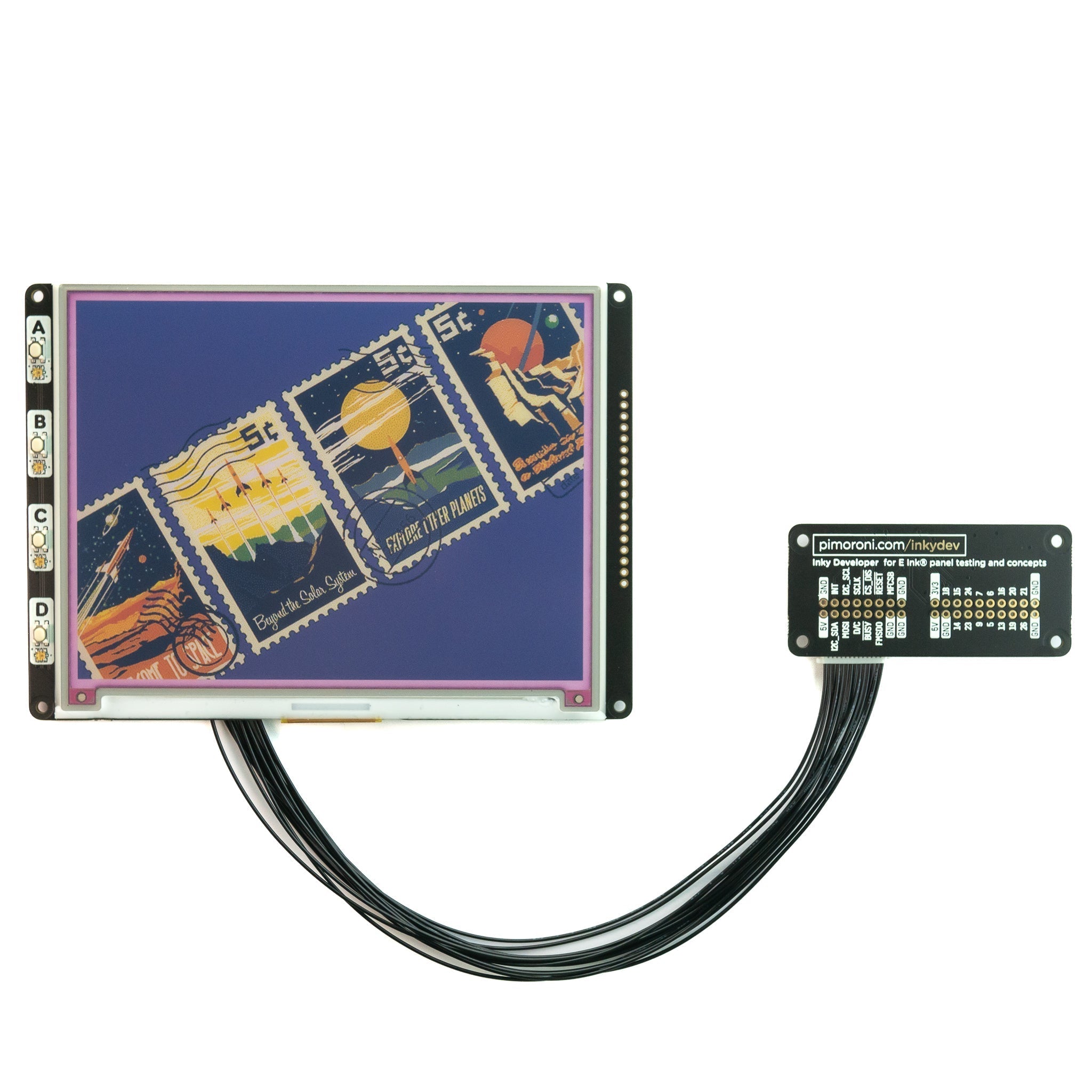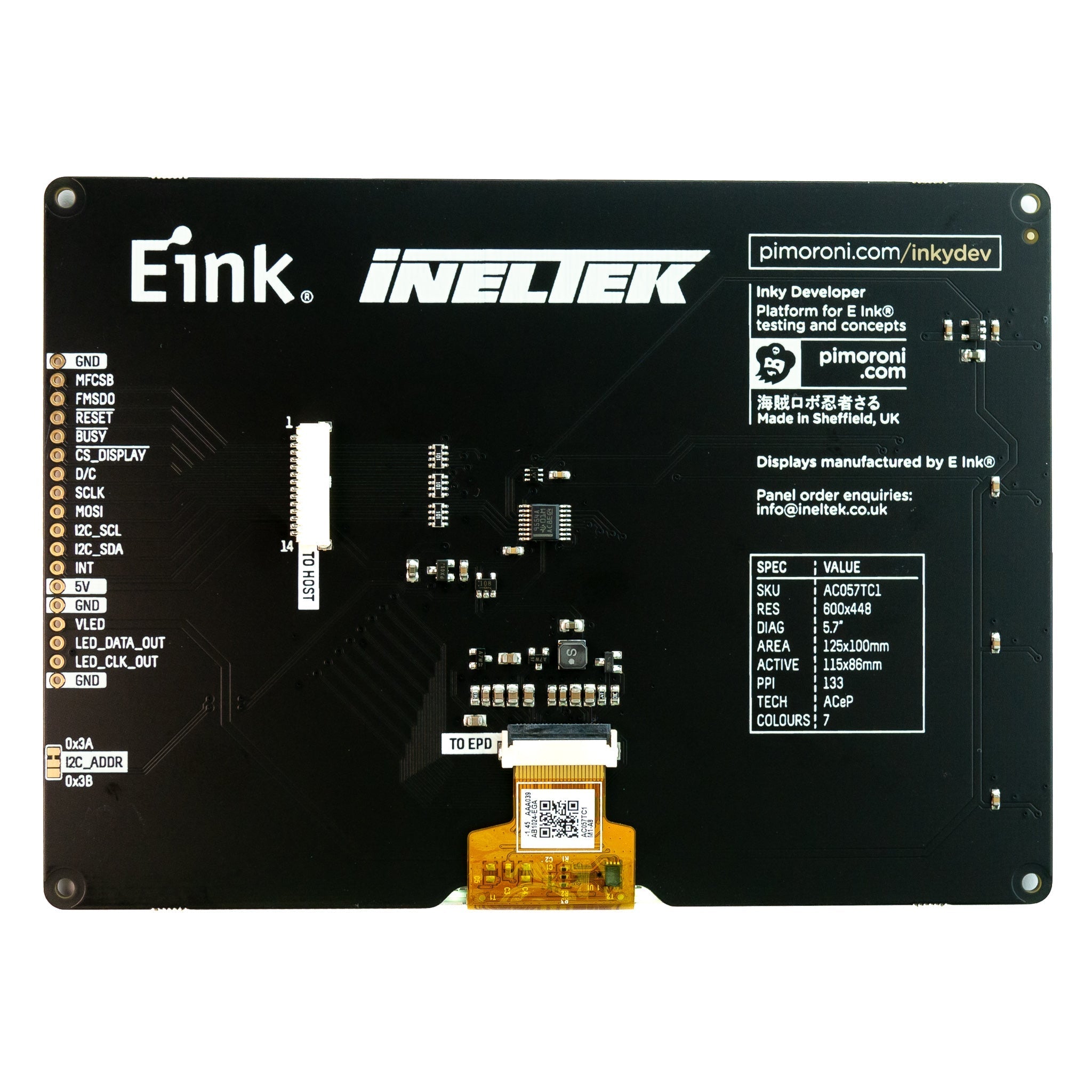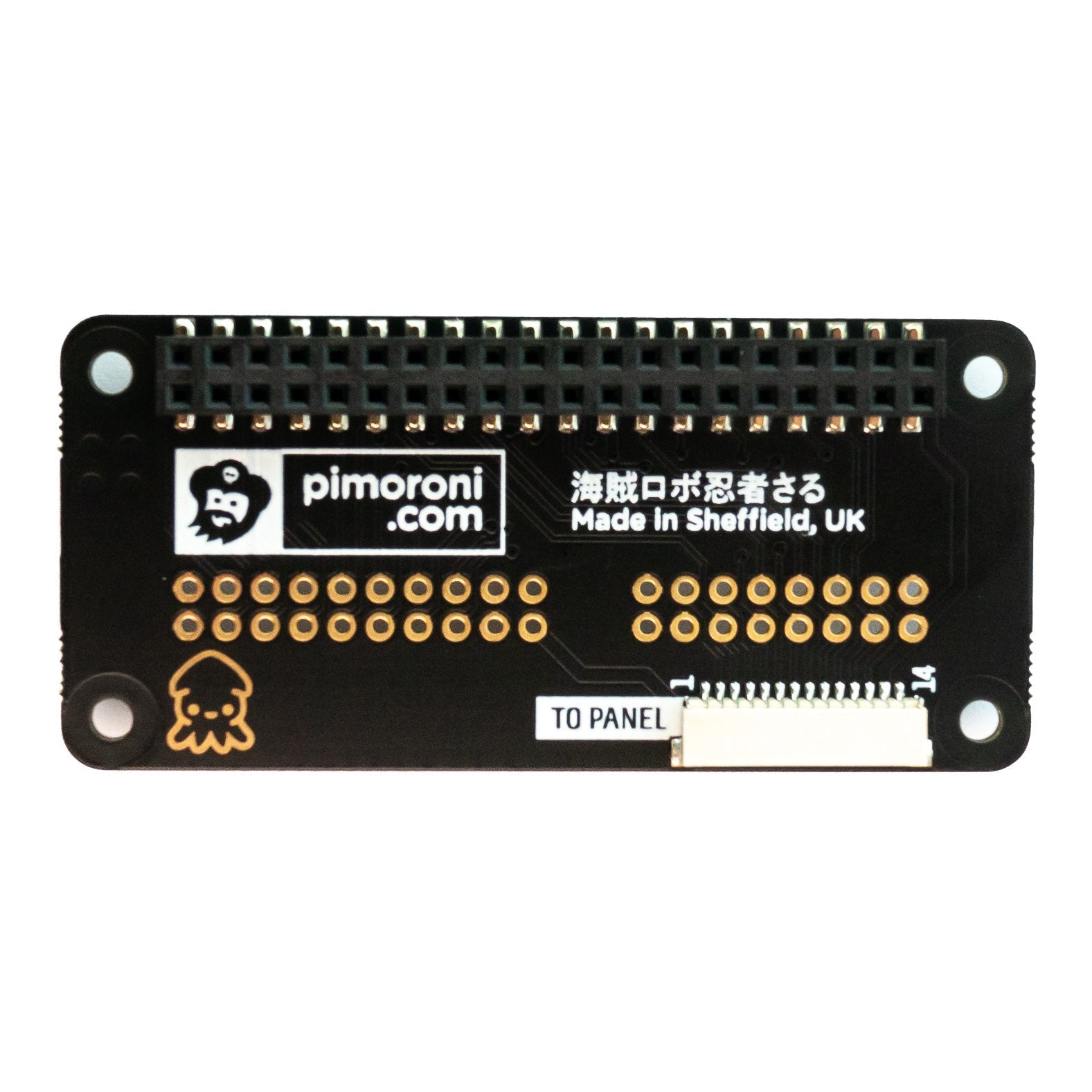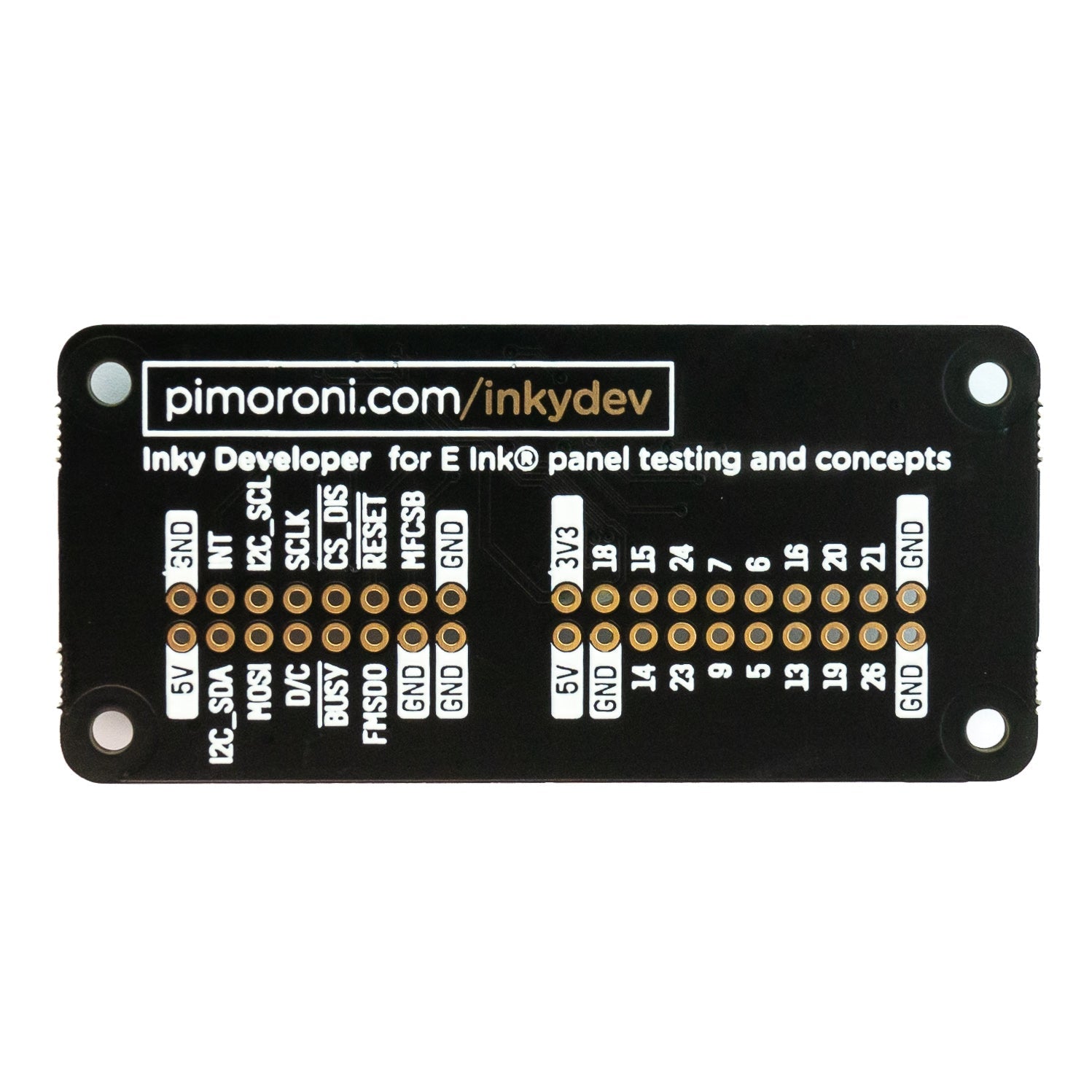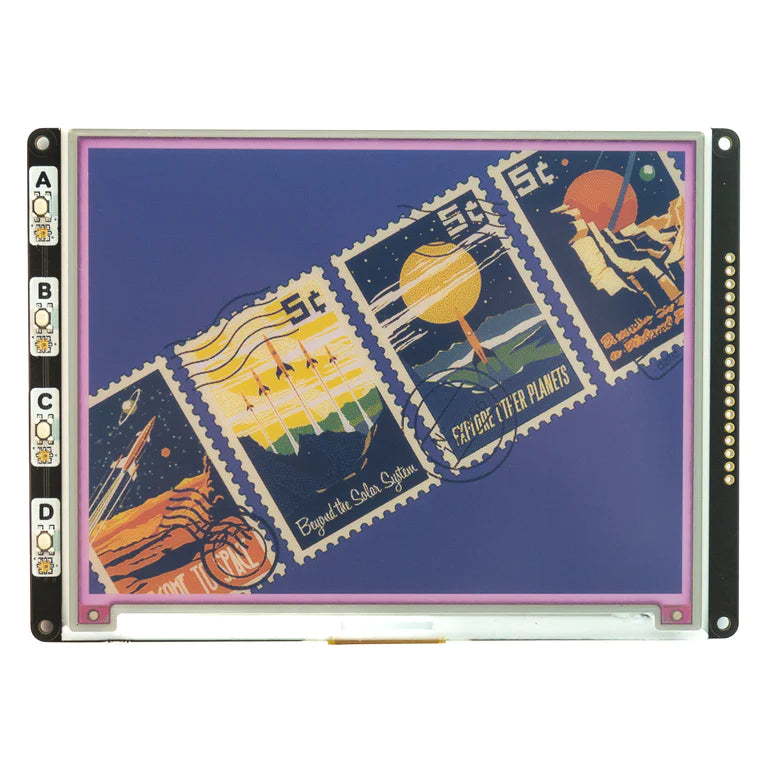Ein leistungsfähiges modulares System für Entwickler, die in der Lage sein wollen, Mikrocontroller/SBC-Hostboards und verschiedene ePaper- oder E Ink®-Displays zu kombinieren.
Inky Developer wurde in Zusammenarbeit von Pimoroni und ihren Freunden bei Ineltek entwickelt und bietet Entwicklern viel Flexibilität, um Konzepte zu demonstrieren und verschiedene Arten von ePaper-Displays vorzustellen. Es besteht aus zwei Teilen - einem Host-Platine die per Kabel mit einem Anzeigetafel. Im Moment gibt es nur eine Art von Host und Display, aber es sind weitere in Planung!
Inky Developer bietet einige zusätzliche Funktionen, die Sie in Pimoronis Standard-Inky-Produktreihe nicht finden werden. Die Anzeigetafel bietet nicht nur eine robuste Basis für das ePaper-Panel, sondern verfügt auch über vier Tasten für Eingänge, vier RGB-LEDs für visuelles Feedback und unterstützt eine Energiesparender Schlafmodus . Alle diese Funktionen sind über einen I2C-I/O-Expander verbunden, so dass sie nur ein Minimum an Pins auf Ihrem Host-Mikrocontroller oder SBC benötigen. Pimoroni hat auch ausgebrochene Kopfzeilen für so viele Pins wie möglich auf beiden Boards, so dass es viele Möglichkeiten gibt, zusätzliche Hardware anzuschließen.
Erfahren Sie mehr über Inky Developer in dieses Video von GSeph Electronics!
Hostboards und Displays sind separat erhältlich also besorgen Sie sich unbedingt eines von beiden! Jedes Host-Board wird mit einem JST-SH-Kabel geliefert.
Mini HAT (Host) Merkmale
- 14-poliger JST-SH-Stecker zum Anschluss an das Display
- Zusätzliche Header aufgeschlüsselt (Display-Pins und restliche Pi-Pins)
- M2.5 Befestigungslöcher
- Vorgelötete Buchsenleiste für den Anschluss an den Raspberry Pi
- Kompatibel mit allen Raspberry Pi-Modellen mit einer 40-poligen Stiftleiste.
- Vollständig montiert
- Es ist kein Löten erforderlich (es sei denn, Sie wollen die herausgebrochenen Stiftleisten verwenden).
- Python-Bibliothek
5.7" Display Eigenschaften
- 5,7" EPD-Display (600 x 448 Pixel), angesteuert über SPI
- E Ink® Gallery Palette™ 4000 ePaper
- ACeP (Advanced Color ePaper) 7-farbig mit schwarz, weiß, rot, grün, blau, gelb, orange.
- Ultraweiter Betrachtungswinkel - >170°
- Punktabstand - 0,1915 x 0,1915 mm
- Vier taktile Tasten
- Four RGB LEDs (APA102)
- Tasten, LEDs und Stromsparmodus werden über einen IO-Expander (TCA9554A) gesteuert
- 14-poliger JST-SH-Stecker für den Anschluss an den Host
- Zusätzliche Pins herausgebrochen (Display-Pins und zusätzlicher APA102-Ausgang)
- M2.5 Befestigungslöcher
Mini HAT (Host) Umfasst
- Inky Dev HAT Mini
- 14-poliges JST-SH-Kabel (300mm, gleichseitige Stecker)
Anmerkungen
- Sowohl die Host- als auch die Displayplatine haben ausgebrochene Header für die Displaypins, so dass man sie mit einer alternativen Verdrahtung anschließen kann, wenn man kein JST-SH-Kabel verwenden möchte.
- Der Mini HAT enthält unbestückte Stiftleisten, die einen einfachen Zugang zu unbenutzten Raspberry Pi-Pins (plus Strom und Masse) ermöglichen.
- Die Displayplatinen enthalten eine Reihe von Headern für die APA102-Pins, so dass es möglich ist, weitere LEDs an die Kette auf der Vorderseite der Platine anzuschließen!
English Description
A powerful modular system for developers who want to be able to mix and match microcontroller/SBC host boards and different ePaper or E Ink® displays.
Developed in conjunction with Pimoroni and friends at Ineltek, Inky Developer allows developers plenty of flexibility to demonstrate concepts and showcase various types of ePaper displays. It consists of two parts - a host board which connects by cable to a display board. There's just one kind of host and display available right now, but there are more in the pipeline!
Inky Developer includes some extra functionality that you won't find on Pimoronis standard Inky range. As well as providing a sturdy base for the ePaper panel, the display board has four buttons for inputs, four RGB LEDs for visual feedback and it supports a low power sleep mode. All these functions are connected up via an I2C I/O expander so they use up a minimum of pins on your host microcontroller or SBC. Pimoroni have also broken out headers for as many pins as possible on both boards, so there's plenty of options for connecting up extra hardware.
Find out more about Inky Developer in this video by GSeph Electronics!
Host boards and displays are sold separately so make sure you pick up one of each! Each host board comes with a JST-SH cable.
Mini HAT (Host) Features
- 14 pin JST-SH connector for attaching to display
- Additional headers broken out (display pins and remaining Pi pins)
- M2.5 mounting holes
- Pre-soldered socket header for attaching to Raspberry Pi
- Compatible with all models of Raspberry Pi with a 40 pin header.
- Fully assembled
- No soldering required (unless you want to use the broken out headers).
- Python library
5.7" Display Features
- 5.7" EPD display (600 x 448 pixels), driven via SPI
- E Ink® Gallery Palette™ 4000 ePaper
- ACeP (Advanced Color ePaper) 7-color with black, white, red, green, blue, yellow, orange.
- Ultra wide viewing angle – >170°
- Dot pitch – 0.1915 x 0.1915mm
- Four tactile buttons
- Four RGB LEDs (APA102)
- Buttons, LEDs and low power mode driven through an IO expander (TCA9554A)
- 14 pin JST-SH connector for attaching to host
- Additional pins broken out (display pins and additional APA102 output)
- M2.5 mounting holes
Mini HAT (Host) Includes
- Inky Dev HAT Mini
- 14 pin JST-SH cable (300mm, same side connectors)
Notes
- Host and display boards both have broken out headers for the display pins, so you can connect them with alternate wiring if you don't want to use a JST-SH cable.
- The Mini HAT includes unpopulated headers to provide easy access to unused Raspberry Pi pins (plus power and ground).
- The display boards include a set of headers for the APA102 pins, so it's possible to add more LEDs onto the chain that's on the front of the board!
Sicherheitsangaben
- Lesen Sie die Bedienungsanleitung sorgfältig durch, bevor Sie das Produkt verwenden.
- Stellen Sie sicher, dass alle Montage- und Installationsanweisungen des Herstellers sorgfältig befolgt werden.
- Verwenden Sie das Produkt nur für den vorgesehenen Zweck.
- Die unsachgemäße Nutzung dieses Produkts kann zu schweren Verletzungen oder Sachschäden führen.
- Nicht für Kinder unter 10 Jahren geeignet.
- Bei unsachgemäßer Verwendung besteht eine Verletzungsgefahr.
- Dieses Produkt entspricht den geltenden Sicherheitsanforderungen der Europäischen Union.
- Dieses Produkt wurde gemäß der GPSR geprüft, die sicherstellt, dass alle relevanten Sicherheitsanforderungen für Konsumgüter eingehalten werden.
Nachverfolgbarkeitsinformationen
Jedes Produkt verfügt über eines oder mehrere der folgenden Merkmale:
- Ein CE-Kennzeichen, das die Einhaltung der Sicherheits-, Gesundheits- und Umweltschutzanforderungen der Europäischen Union anzeigt.
- Eine eindeutige Serien- oder Chargennummer, um die Nachverfolgbarkeit zu gewährleisten und bei Bedarf Rückrufaktionen zu unterstützen.
- Hersteller- und Importeurangaben für den Kundensupport und Sicherheitsanfragen.
Überwachung und Berichterstattung von Vorfällen
Für den unwahrscheinlichen Fall eines Produktproblems haben wir Verfahren implementiert, um:
- Kundenbeschwerden zeitnah bearbeiten.
- Schwerwiegende Vorfälle über das EU Safety Gate/RAPEX-System melden.
- Mit den Marktüberwachungsbehörden zusammenarbeiten, um die öffentliche Sicherheit zu gewährleisten.
Kontakt:
- Email: support [@] pi3g.com
- Telefon: 0341 / 392 858 40
Dieses Produkt ist vollständig mit allen geltenden EU-Vorschriften konform, um die Sicherheit unserer geschätzten Kunden zu gewährleisten.

